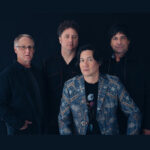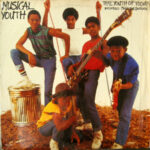 When people think of iconic American rock bands, names like Bruce Springsteen, Pearl Jam, and The Foo Fighters often come to mind. However, one band that has quietly built a loyal fanbase and sustained a career over several decades without ever reaching the mainstream heights of their contemporaries is Big Head Todd and the Monsters. Known for their distinctive mix of blues, rock, and alternative influences, the band has developed a sound that is uniquely their own. From their humble beginnings in the late 1980s to their continued presence on the live music scene today, Big Head Todd and the Monsters have always managed to fly under the radar while creating music that is both timeless and consistently innovative.
When people think of iconic American rock bands, names like Bruce Springsteen, Pearl Jam, and The Foo Fighters often come to mind. However, one band that has quietly built a loyal fanbase and sustained a career over several decades without ever reaching the mainstream heights of their contemporaries is Big Head Todd and the Monsters. Known for their distinctive mix of blues, rock, and alternative influences, the band has developed a sound that is uniquely their own. From their humble beginnings in the late 1980s to their continued presence on the live music scene today, Big Head Todd and the Monsters have always managed to fly under the radar while creating music that is both timeless and consistently innovative.
In this article, we will take an in-depth look at Big Head Todd and the Monsters’ formation, their discography, their evolution over time, and their place in the broader landscape of American rock music. Through examining their journey, we’ll uncover the reasons why the band has earned the loyalty of fans across the country and why their contribution to the music industry remains deeply underrated.
1. The Origins of Big Head Todd and the Monsters
The Formation of the Band (1986)
Big Head Todd and the Monsters were formed in 1986 in Coloardo, where they quickly became a fixture in the local music scene. The band was originally made up of Todd Park Mohr (vocals and guitar), Rob Squires (bass guitar), and Brian Nevin (drums). The group’s name, a quirky and memorable one, came from a nickname Mohr had received from his bandmates due to his large head, which they jokingly referred to as a “big head,” while his “Todd” moniker also added a playful element to the band’s identity.
Early Years and Influences
The band members were influenced by a range of musical genres, from blues to classic rock to alternative. In particular, Todd Park Mohr was influenced by the sounds of Chicago blues and Southern rock. These influences would be reflected in Big Head Todd’s early music, setting them apart from the more mainstream, radio-friendly rock bands of the time. The trio began performing locally, and after gaining recognition in Boulder and Denver, they were eventually able to make a name for themselves regionally.
Despite being somewhat obscure at the time, the band’s unique fusion of blues, rock, and folk influences began to resonate with local music lovers, setting the foundation for their eventual rise to fame.
2. The Breakthrough: Sister Sweetly (1993)
Introduction to the National Stage
Big Head Todd and the Monsters’ breakthrough came with the release of their third studio album, Sister Sweetly (1993). This album would propel them into the national spotlight, and it is still considered by many to be the band’s defining record. The album was produced by Tchad Blake, known for his work with Los Lobos, Tom Waits, and The Black Crowes. Sister Sweetly captured the essence of what Big Head Todd and the Monsters were about: a mix of heartfelt lyrics, blues-infused guitar work, and a deep connection to American musical traditions.
Critical Success and Commercial Appeal
With Sister Sweetly, the band achieved significant commercial success. The album produced two hit singles, “Bittersweet” and “Broken Hearted Savior”, which became staples of alternative rock radio during the early ‘90s. These songs were not just catchy rock anthems—they displayed a level of emotional depth that resonated with listeners across a wide range of demographics. “Bittersweet” in particular captured the melancholic beauty of unrequited love, while “Broken Hearted Savior” was a powerful reflection on loss and redemption.
The album was both critically acclaimed and commercially successful, peaking at #1 on the Billboard Heatseekers chart and earning the band a reputation for their ability to combine rock-driven instrumentation with soulful introspection. The success of Sister Sweetly laid the foundation for Big Head Todd and the Monsters’ continued rise to fame.
3. Evolution and Exploration: Post-Sister Sweetly Era
Strategem (1997) and the Shift Toward Rock Exploration
After the success of Sister Sweetly, Big Head Todd and the Monsters released Strategem (1997), which marked a shift in the band’s sound. The album leaned more heavily into rock and alternative influences, incorporating elements of jam band culture. Tracks like “Please Don’t Tell Her” and “Boom Boom” showed a willingness to experiment and explore different musical textures, while still maintaining the soulful core that had earned them their original following.
While Strategem wasn’t as commercially successful as its predecessor, it was a critical success, showcasing the band’s continued growth as musicians and songwriters. The album solidified their reputation for blending genres, but the success of Sister Sweetly had set a high bar, making it difficult to match or surpass. Nonetheless, Strategem still had a strong impact, particularly on the jam band scene, and showed that Big Head Todd and the Monsters were not a one-hit wonder.
Further Experiments with Sound: Beautiful World (2004)
The band’s next release, Beautiful World (2004), continued to build upon the alternative rock and blues influences that had characterized their earlier work, but this time the album incorporated a more polished production style. This record showed a more refined approach to their sound, with a noticeable emphasis on softer acoustic arrangements paired with deeper, more mature lyrics. The title track, “Beautiful World”, explored themes of self-reflection and emotional resilience, while other tracks like “The Last Polka” carried a more laid-back, almost folksy feel.
Beautiful World was another solid addition to their discography, but it also marked a point where Big Head Todd and the Monsters began to move away from the mainstream spotlight and more into the realm of underground recognition. The album didn’t achieve the same level of commercial success as Sister Sweetly, but it further developed the band’s identity as a hard-to-pigeonhole act that defied the trends of the mainstream music industry.
4. Maintaining Relevance in the 21st Century: Touring and Continuing to Evolve
Live Performances and Fanbase
One of the reasons Big Head Todd and the Monsters has remained so beloved by fans is their consistent commitment to live performances. The band’s reputation as a stellar live act has kept them relevant throughout the years, allowing them to maintain a loyal fanbase despite not releasing chart-topping albums in recent years.
The band is particularly known for their jam-band-style live performances, which include extended improvisations, audience interaction, and a general sense of musical freedom that separates their concerts from more standard rock shows. Fans who attend Big Head Todd and the Monsters’ live shows are treated to a dynamic, spontaneous experience that showcases the band’s remarkable musicianship and their ability to breathe new life into their songs.
The Challenge of Consistency
Throughout the 2000s and 2010s, Big Head Todd and the Monsters continued to tour and release new albums, including All the Love You Need (2010) and New World Arisin’ (2014). While neither album achieved the same level of mainstream success as Sister Sweetly, both albums showcased the band’s ability to continue evolving their sound while remaining true to their core influences.
These albums are characterized by rich, bluesy textures, improvised solos, and lyrics that grapple with personal identity and social commentary. They might not have broken new ground in the way their earlier records did, but they offered a glimpse into the continued maturation of the band and the refinement of their musical vision. The band’s continued success on the live circuit and with their devoted fanbase further illustrates the band’s enduring popularity despite shifting musical tastes.
5. Legacy and Influence: Big Head Todd’s Place in Rock History
An Underrated Contribution to the Rock Landscape
Big Head Todd and the Monsters might not have reached the same commercial heights as some of their peers from the 1990s alt-rock boom, but their steady output of music and commitment to their craft has earned them a respected place in the annals of American rock music. The band has influenced countless musicians, particularly within the jam band and roots-rock communities.
Their eclectic fusion of genres, from blues to rock to folk, has influenced a generation of musicians looking to explore the borders of these genres while still retaining a sense of authenticity. While they may have never achieved the same level of fame as bands like The Dave Matthews Band or Widespread Panic, their influence in those circles is undeniable.
Continuing to Grow and Evolve
Today, Big Head Todd and the Monsters continue to tour and record music. Their long-standing commitment to their craft is a testament to the lasting power of their sound, one that has transcended trends and fads to maintain relevance in an ever-changing music industry. Their fans remain as dedicated as ever, attending live shows and supporting their albums, while new listeners continue to discover the band’s unique blend of rock and blues.
As a band that has always preferred to march to the beat of its own drum, Big Head Todd and the Monsters have firmly established themselves as one of the most enduring and respected acts in the American rock scene.
Conclusion: Big Head Todd and the Monsters—A Band Worth Remembering
Big Head Todd and the Monsters may not have achieved the level of mainstream success that many of their contemporaries enjoyed, but their impact on rock music is profound. Their authenticity, musicianship, and commitment to artistic integrity have allowed them to carve out a lasting legacy in the rock world. From their breakthrough with Sister Sweetly to their continued evolution in the 21st century, the band has consistently proven that longevity in the music industry is about more than just radio hits—it’s about the ability to grow, adapt, and connect with fans on a deeper level.
As an underrated band, Big Head Todd and the Monsters have managed to maintain a steadfast presence in a constantly changing musical landscape. Their contribution to rock music is undeniable, and their place in the history of American music is secure—even if they never quite achieved the commercial heights they deserve.
This post has already been read 98 times!









